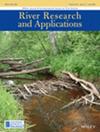Going to the archives: Combining palaeoecological and contemporary data to support river restoration appraisals
IF 1.9
4区 环境科学与生态学
Q4 ENVIRONMENTAL SCIENCES
引用次数: 0
Abstract
River restoration practices are being increasingly implemented to help offset the global degradation of freshwater ecosystems. The ecological success of such projects is typically determined via post‐project appraisals comparing restored conditions against specified baselines (e.g., pre‐project and/or non‐restored data), but such approaches can overlook broader ecosystem recovery patterns. Using freshwater macroinvertebrate communities, this study examined ecological responses to river restoration that are seldom assessed: (i) sub‐annual temporal trajectories and (ii) palaeoecological versus contemporary community comparisons. Palaeoecological samples contained assemblages that existed prior to major anthropogenic pressures, which were collected from a sinuous palaeochannel that was restored and reconnected during the study; after which contemporary macroinvertebrate samples were collected. The restored channel initially supported an impoverished community, but taxonomic richness and densities were comparable to non‐restored conditions after 13‐months. The freshwater shrimp (查阅档案:将古生态学数据与当代数据相结合,为河流修复评估提供支持
为帮助抵消全球淡水生态系统的退化,河流修复实践越来越多地得到实施。此类项目的生态成功与否通常是通过项目后评估来确定的,将恢复后的状况与指定基线(如项目前和/或未恢复前的数据)进行比较,但这种方法可能会忽略更广泛的生态系统恢复模式。本研究利用淡水大型无脊椎动物群落,考察了很少被评估的河流恢复后的生态响应:(i) 次年度时间轨迹;(ii) 古生态与当代群落比较。古生态学样本包含在主要人为压力出现之前的生物群落,这些样本采集自一条蜿蜒的古河道,该河道在研究期间得到修复并重新连通;之后采集了当代大型无脊椎动物样本。修复后的河道最初支持着一个贫乏的群落,但 13 个月后,其分类丰富度和密度与未修复的情况相当。修复后 7 个月,淡水虾(Gammarus pulex)和非本地新西兰泥螺(Potamopyrgus antipodarum)大量繁殖,后续生物监测显示,5 年后它们仍占主导地位。这些证据表明,恢复后的生态系统动态如何影响长期恢复。与当代样本相比,古生态群落表现出更高的生物多样性和保护价值。这突出表明,自 20 世纪中叶以来,人类活动的压力不断增加,导致大型无脊椎动物群落退化,尤其是限制了边缘栖息和濒临湖泊的专门物种。随着古河道重新连接技术在全球范围内的广泛应用,这项研究证明了在修复工程之前收集古生态数据以提供有价值的基线信息的价值。随着全球人为足迹的增加,合适的 "参考 "河流环境日益退化,古生态学数据可以更好地描述生物多样性损失的特征,并有可能为有效的修复活动提供目标条件。
本文章由计算机程序翻译,如有差异,请以英文原文为准。
求助全文
约1分钟内获得全文
求助全文
来源期刊

River Research and Applications
环境科学-环境科学
CiteScore
4.60
自引率
9.10%
发文量
158
审稿时长
6 months
期刊介绍:
River Research and Applications , previously published as Regulated Rivers: Research and Management (1987-2001), is an international journal dedicated to the promotion of basic and applied scientific research on rivers. The journal publishes original scientific and technical papers on biological, ecological, geomorphological, hydrological, engineering and geographical aspects related to rivers in both the developed and developing world. Papers showing how basic studies and new science can be of use in applied problems associated with river management, regulation and restoration are encouraged as is interdisciplinary research concerned directly or indirectly with river management problems.
 求助内容:
求助内容: 应助结果提醒方式:
应助结果提醒方式:


